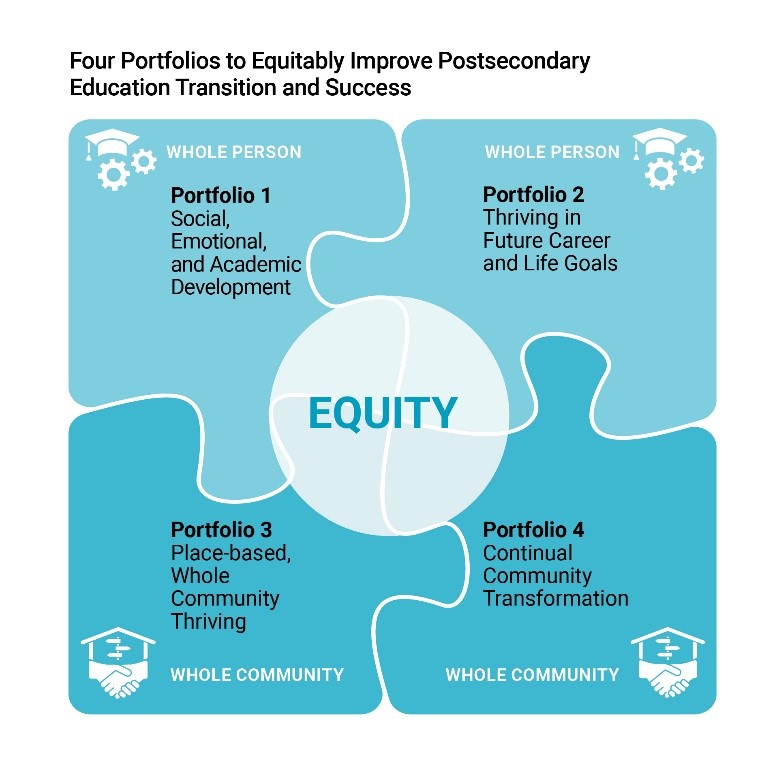To enhance the well-being of individuals and communities, it is critical for all students — particularly those currently most marginalized — to advance their education and training after high school, whether to a four-year institution, vocational training, or another program that meets the student’s needs. With input from more than 40 experts around the US, the Institute for Healthcare Improvement (IHI) and StriveTogether developed a framework to support this ambitious aim and have begun to apply it with seven communities across the country. As described in Building an Equitable System for Postsecondary Education Transition and Success, this approach centers students who are Black, Latinx, first generation college-going, and/or experiencing poverty. This work invites practitioners to think more broadly and in new ways about what it means to support well-being for students, both within schools and together with the community, bringing an explicitly multi-sector and collaborative lens to supporting equity and thriving.
The framework consists of four portfolios (see Figure 1 below) and includes strategies, activities, and sample measures within each. The “Whole Person” portfolios guide work to achieve student well-being, now and in the future. The “Whole Community” portfolios guide work on community well-being, now and in the future. The framework also includes guiding principles to promote system transformation. To co-create an equitable system for postsecondary transition and success, the expectation is for educational practitioners to partner with students to 1) align existing efforts; and 2) identify new directions to produce more equitable systems.

Figure 1 — Portfolios to Equitably Improve Postsecondary Education Transition and Success
Seven place-based partnerships — who are members of StriveTogether’s Cradle-to-Career Network — take part in a Postsecondary Transitions Action Community (PTAC). PTAC participants learn about, integrate, and share their use of the framework. Even amid the upheaval created by the COVID-19 pandemic, PTAC communities brought together cross-sector partners to connect their work to one or more of the portfolios; deepen engagement with parents, students, and community members; and use the framework as a tool for alignment.
Northfield Promise, a PTAC community anchored in the Healthy Community Initiative in Northfield, Minnesota, learned how best to support students and families during COVID-19 by conducting student and family interviews. They shared their findings with school and district partners, and connected students to resources to meet their identified needs, including free or low-cost home internet access and food deliveries from the local food shelf during remote learning. Northfield’s Tackling Obstacles and Raising College Hopes (TORCH) program offered students ongoing academic support, holistic advising, referrals to mental and physical health care providers, leadership development opportunities, and financial literacy and career exploration resources. They also facilitated ways for students experiencing poverty and students of color to participate in local government.
We have learned these lessons thus far:
• Leading with students and families most affected by inequity is central to advancing equitable system transformation. Meaningfully engaging in this work begins (and continues) with a commitment to co-design and partnership.
• It is critical to develop, practice, and support a range of proficiencies. These include technical skills (e.g., continuous improvement and measurement) and relational skills (e.g., leading with students and families most affected by inequity and partnership-building across education and community settings).
• COVID-19 and this country’s reckoning with systemic-racism created and exposed significant challenges. These circumstances created a powerful call to create systems that support those most affected by inequities. This work happening at this moment encouraged communities to dig into the work in powerful ways that can ultimately build lasting change.
We look forward to learning from and with practitioners and communities across the US as they work to transform the education system to support postsecondary completion for all students, especially for those currently most marginalized. We hope this framework will help us create a world in which all students and their communities can thrive.
Authors: Marianne McPherson and Heidi Black
Marianne McPherson is a senior director at the Institute for Healthcare Improvement (IHI), an independent not-for-profit organization based in Boston, Massachusetts, USA. IHI uses improvement science to advance and sustain better outcomes in health and health systems across the world.
Heidi Black is the director of collaborative improvement at StriveTogether, a non-profit organization that supports place-based partnerships to transform the education system so that a child's potential isn't dictated by race, ethnicity, zip code or circumstance. Learn more at www.strivetogether.org.



